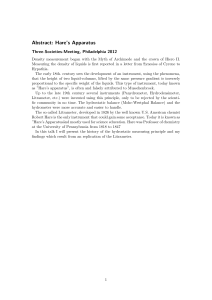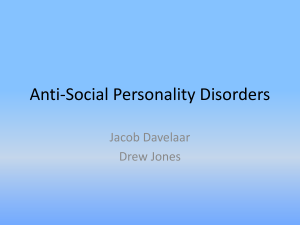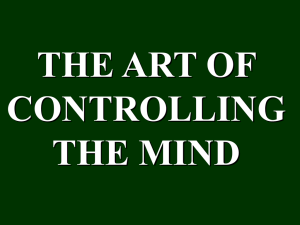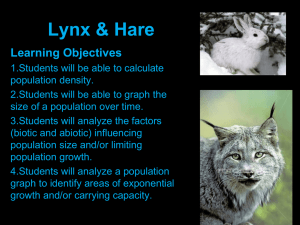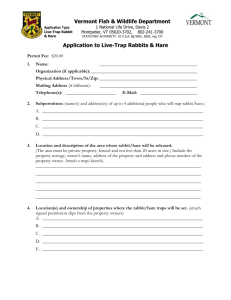powerpoint - Sisters Inside
advertisement
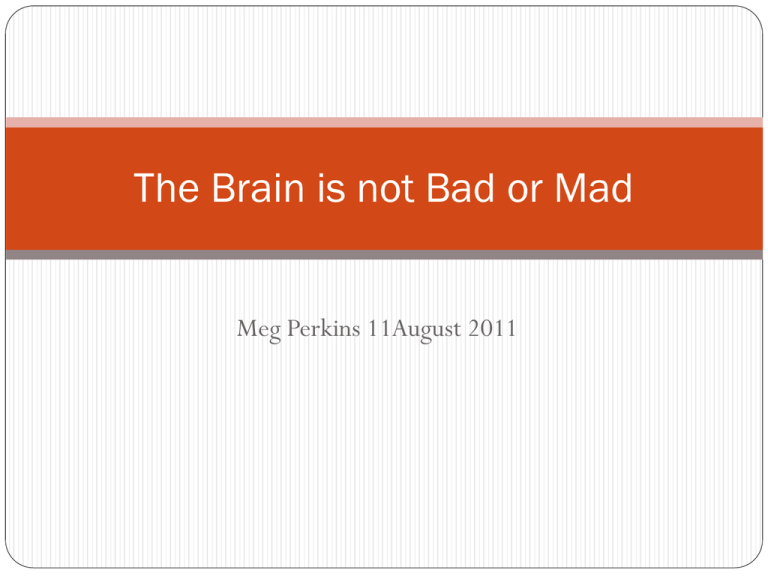
The Brain is not Bad or Mad Meg Perkins 11August 2011 definition of mad - 1843 Legal definition of insanity such a defect of reason, from disease of the mind, as not to know the nature and quality of the act he was doing; or, if he did know it, that he did not know he was doing what was wrong 1843 Not guilty! medical definitions Bipolar affective disorder/Schizophrenia Drug induced psychosis Many people with these disorders are in prison 28% of Indigenous women prisoners have been psychotic in the previous 12 months (Qld 2008) 10% male and 15% female reception psychosis (Butler & Allnutt in New South Wales 2003) 3% in the general population Trauma and PTSD Overwhelming fear Overactive limbic system Red alert switch is faulty or ON Outbursts of anger, survival mode Numb and detached from others May be “paranoid” or hallucinate More severe if trauma ongoing 25% of prisoners have PTSD (at least) Intellectual disability/impairment Head injuries or... 80 different medical conditions Affect development of the brain Cared for by parents and (over)protected If parents/relatives are unable or unwilling to care Many people with these conditions are in prison 60-80% head injuries, 8-9% gen pop (Perros 2010) 45% borderline or full ID (British study Hayes 2007) definition of bad – 1941/1993 Psychopath Hervey Cleckley/Robert Hare Without conscience No respect for the rights of others This person does as s/he likes and is dangerous history of an idea Psychopathology is disease of the mind or soul Possession by demons or born without a soul Hervey Cleckley 1941 interviewed men in prison Psychopathic personality (psychoanalysis) Lack of internal personality structure Freud’s Id Ego and Superego – no superego 70 years ago – brilliant and persuasive Robert Hare’s idea PCL-R developed in the 1980s Did not report the knife that his first client Ray showed him. This man made many demands on him and he says that “Ray made my eight month stint at the prison miserable”. Hare refused to get Ray a job when he applied for parole. Ray knew that Hare’s father was a roofing contractor. Hare’s car was tampered with in the prison auto shop. He decided later that Ray was a psychopath. Dangerous people There are dangerous people A few who enjoy violent crimes Not always a Hare psychopath There is no such thing as a psychopath except as defined by Robert Hare Robert Hare It appears that psychopaths are unable or unwilling to process or use the deep semantic and affective meanings of language... Hare PCL-R 2nd Edition Technical Manual p112 But the research says that Hare psychopaths have difficulty using language to tell stories and difficulty expressing abstract or affective (emotional) concepts... Kent Kiehl and Joshua Buckholtz “Inside the Mind of a Psychopath” Scientific American Mind Kiehl has helped design a portable functional MRI scanner that can be taken inside a prison Studying psychopaths to prevent the offending behaviour and develop effective treatments “not monsters but people whose emotional disabilities may cause them to act monstrously” Research by Robert Hare and associates* Have difficulty feeling emotions Struggle to “read between the lines” and read social cues Often of better-than-average intelligence Suffer from a serious biological deficit Learning disability that impairs emotional development Specific physiological deficits prevent empathizing, stable relationships and learning from mistakes *Scientific American Mind: September/October 2010 Research continued Lack access to feelings, body sensations Oblivious to emotional cues, can’t hear fear in voice Can’t see fear in someone’s face Miss the emotional nuances of language Trouble understanding metaphors Difficulty in shifting attention Fearless in dangerous situations Paralimbic system underdeveloped on fMRI scans Paralimbic system Orbitofrontal cortex – sensitivity to risk, reward and punishment, damage causes impulsivity and lack of insight Amygdala malfunction may result in fearlessness Anterior cingulate cortex – reward anticipation, decision making, empathy and emotion Insula – recognizing violations of social norms, as well as experiencing anger, fear, empathy and disgust Also pain perception the insula According to neuroscientists who study it, the insula is a long-neglected brain region that has emerged as crucial to understanding what it feels like to be human. They say it is the wellspring of social emotions, things like lust and disgust, pride and humiliation, guilt and atonement. It helps give rise to moral intuition, empathy and the capacity to respond emotionally to music. (Recognising the violation of social norms) A Small Part of the Brain and its Profound Effects Sandra Blakeslee ,The New York Times Mental Health and Behaviour Feb 6, 2007 uncinate fasciculus Dr Michael Craig 2009 Kings College London using DT MRI Abnormalities in the white matter connecting The amygdala and the orbitofrontal cortex More extreme scores on PCL-R more dysfunction in the uncinate fasciculus Understanding and treatment DTI Tractography of the Arcuate, Inferior Longitudinal, and Uncinate Fasciculus. Relevant publications from our lab Phillips OR, Nuechterlein KH, Clark KA, Hamilton LS, Asarnow RF, Hageman NS, Toga AW, Narr KL. (2008) Fiber Tractography Reveals Disruption of Temporal Lobe White Matter Tracts in Schizophrenia. Schizophrenia Research, (2008) Schizophrenia and Psychopathy This study examined three major white matter tracts connecting lateral and medial temporal lobe regions with neocortical association regions widely implicated in systemslevel functional and structural disturbances in schizophrenia. Disruptions of connectivity within these pathways may potentially contribute to the disturbances of memory, language, and social cognitive processing. www.loni.ucla.edu/~narr/project.php?q=sztract higher level language skills speech and language pathologist Making inferences Difficulties Sequencing Not see consequences Negative questions Problem solving Predicting Determining causes Not link behaviour to result/not understanding why he is punished Not link emotion to events Can’t read between the lines/see implications Not learn from mistakes Pamela Snow and Martine Powell Oral Language Competence, Social Skills and High-risk Boys: What are Juvenile Offenders Trying to Tell us? Children and Society 2008 Oral language competency Basis for relationships and literacy skills/education Young people In Custody 61% language impaired Autism and Asperger’s syndrome Autistische Psychopathen (1930s) Autistic Psychopath (in German not “evil”) Difficulty making friends Impaired non-verbal communication Impaired communication of emotion Impaired empathy PDD NOS A severe and pervasive impairment in the development of reciprocal social interaction associated with impairment of either verbal or non-verbal communication skills or stereotyped behaviour Pervasive developmental disorder not otherwise specified (autistic spectrum) PDA pathological demand avoidance syndrome Socially manipulative, disruptive Imitate inappropriate behaviour Need to dominate and control due to social anxiety, resist demands of everyday life Cognitive deficits, neurological pathologies Punishment is ineffective with these children and behavioural techniques fail www.pdacontact.org.uk In prison for disability Mental illness Intellectual or learning disability Psychopath OR Posttraumatic Stress Disorder? Communication problem? Neuro-behavioural disability? alternatives Therapeutic jurisprudence.“One of the things therapeutic jurisprudence tries to do is to look carefully at promising literature from psychology, psychiatry, clinical behavioral sciences, criminology and social work to see whether those insights can be incorporated or brought into the legal system” (Wexler 1999). Restorative justice “actively involves both offenders and victims in reparation and rehabilitation”. (Van Ness 1997) Early intervention and prevention. “ Crime and delinquency are in large measure responses to frustration and inequality”. (Palmer 1973). School assessments of mental health and cognitive skills, psychotherapy and skills training.
